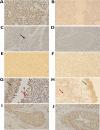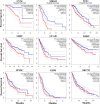Exploring heterogeneous expression of beta-actin (ACTB) in bladder cancer by producing a monoclonal antibody 6D6
- PMID: 38867273
- PMCID: PMC11167769
- DOI: 10.1186/s12894-024-01489-6
Exploring heterogeneous expression of beta-actin (ACTB) in bladder cancer by producing a monoclonal antibody 6D6
Abstract
Background: To predict outcomes and identify potential therapeutic targets for cancers, it is critical to find novel specific biomarkers. The objective of this study was to search for and explore novel bladder cancer-associated protein biomarkers.
Methods: A library of monoclonal antibodies (mAbs) against the JAM-ICR cell line was first generated, and clones with high affinity were selected. Hybridomas were screened using bladder cancer (BLCA) cell lines and normal cells. The target of the selected mAb was then characterized through immunoaffinity purification, western blotting, and mass spectrometry analysis. Expression of the target antigen was assessed by flow cytometry and IHC methods. Several databases were also used to evaluate the target antigen in BLCA and other types of cancers.
Results: Based on screenings, a 6D6 clone was selected that recognized an isoform of beta-actin (ACTB). Our data showed that ACTB expression on different cell lines was heterogeneous and varied significantly from low to high intensity. 6D6 bound strongly to epithelial cells while showing weak to no reactivity to stromal, endothelial, and smooth muscle cells. There was no association between ACTB intensity and related prognostic factors in BLCA. In silico evaluations revealed a significant correlation between ACTB and overexpressed genes and biomarkers in BLCA. Additionally, the differential expression of ACTB in tumor and healthy tissue as well as its correlation with survival time in a number of cancers were shown.
Conclusions: The heterogeneous expression of ACTB may suggest the potential value of this marker in the diagnosis or prognosis of cancer.
Keywords: ACTB; Beta-actin; Biomarkers; Bladder cancer; Hybridoma; Monoclonal antibody.
© 2024. The Author(s).
Conflict of interest statement
The authors declare no potential conflicts of interest.
Figures









Similar articles
-
Prognostic value of TOP2A in bladder urothelial carcinoma and potential molecular mechanisms.BMC Cancer. 2019 Jun 19;19(1):604. doi: 10.1186/s12885-019-5814-y. BMC Cancer. 2019. PMID: 31216997 Free PMC article.
-
Production and characterization of monoclonal antibody against a triple negative breast cancer cell line.Biochem Biophys Res Commun. 2018 Oct 20;505(1):181-186. doi: 10.1016/j.bbrc.2018.09.087. Epub 2018 Sep 20. Biochem Biophys Res Commun. 2018. PMID: 30243716
-
Promoter methylation of DNA damage repair (DDR) genes in human tumor entities: RBBP8/CtIP is almost exclusively methylated in bladder cancer.Clin Epigenetics. 2018 Feb 6;10:15. doi: 10.1186/s13148-018-0447-6. eCollection 2018. Clin Epigenetics. 2018. PMID: 29445424 Free PMC article.
-
Immunohistochemical characterisation of the monoclonal antibody BLCA-38 for the detection of prostate cancer.Cancer Immunol Immunother. 2004 Nov;53(11):995-1004. doi: 10.1007/s00262-004-0527-7. Epub 2004 Jul 28. Cancer Immunol Immunother. 2004. PMID: 15449043 Free PMC article.
-
TEAD4 functions as a prognostic biomarker and triggers EMT via PI3K/AKT pathway in bladder cancer.J Exp Clin Cancer Res. 2022 May 17;41(1):175. doi: 10.1186/s13046-022-02377-3. J Exp Clin Cancer Res. 2022. PMID: 35581606 Free PMC article.
Cited by
-
Investigation of new autoantibodies in urothelial bladder cancer for biomarker discovery using immunoproteomics.Discov Oncol. 2025 Mar 31;16(1):436. doi: 10.1007/s12672-025-02167-1. Discov Oncol. 2025. PMID: 40163213 Free PMC article.
-
Pilot study: Initial investigation suggests differences in EMT-associated gene expression in breast tumor regions.Comput Struct Biotechnol J. 2025 Jan 30;27:548-555. doi: 10.1016/j.csbj.2025.01.027. eCollection 2025. Comput Struct Biotechnol J. 2025. PMID: 39981295 Free PMC article.
References
MeSH terms
Substances
Grants and funding
LinkOut - more resources
Full Text Sources
Medical
Miscellaneous

